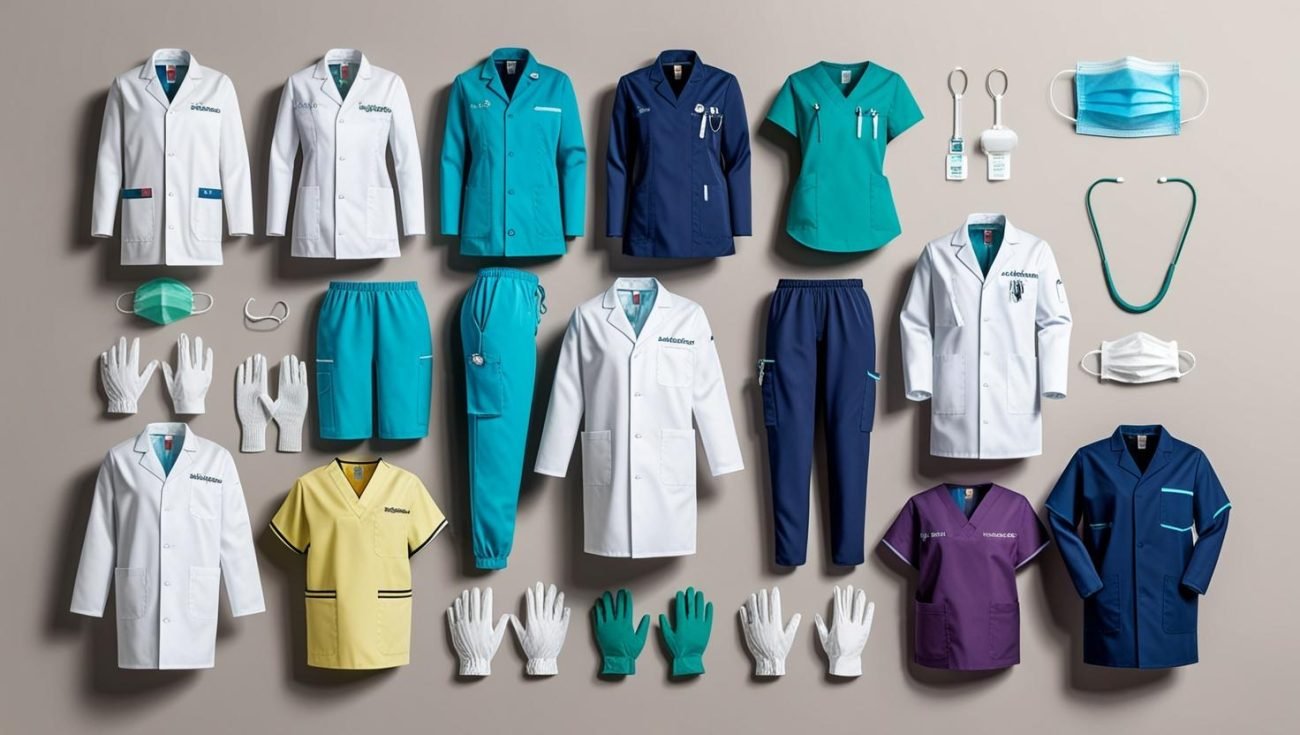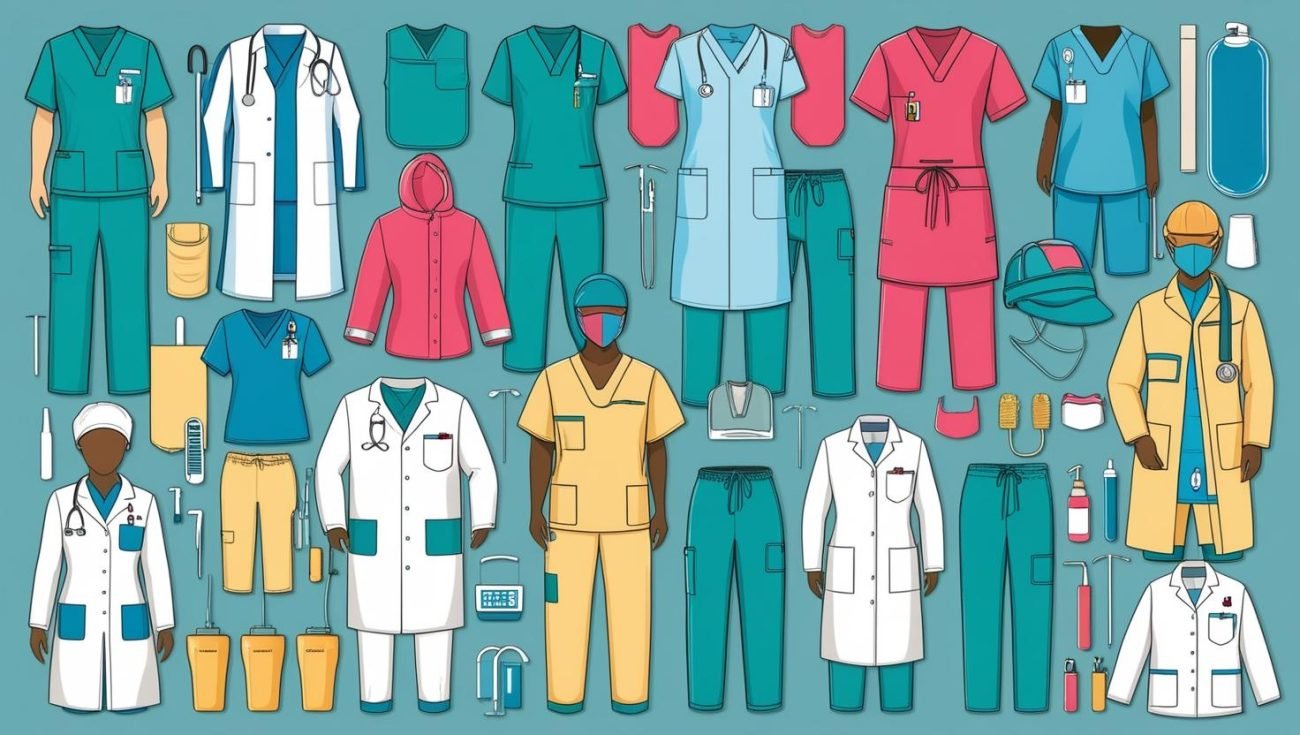Top Trends in Healthcare and Medical Workwear Clothing for Professionals in April 2025
 The healthcare industry has seen significant evolution over recent years, not only in terms of technology and practices but also in how professionals present themselves at work. Medical workwear clothing is no longer just about functionality; it has become a blend of practicality, style, sustainability, and comfort. In April 2025, healthcare and medical workwear trends have embraced advanced textile technology, customization, inclusion, and environmentally friendly designs.
The healthcare industry has seen significant evolution over recent years, not only in terms of technology and practices but also in how professionals present themselves at work. Medical workwear clothing is no longer just about functionality; it has become a blend of practicality, style, sustainability, and comfort. In April 2025, healthcare and medical workwear trends have embraced advanced textile technology, customization, inclusion, and environmentally friendly designs.
Sustainability and Eco-Friendly Fabrics
One of the most significant trends in healthcare workwear this year is the push for sustainability. As the healthcare sector increasingly acknowledges its environmental impact, medical clothing manufacturers are introducing eco-friendly solutions.
- Recycled and biodegradable materials: Many scrubs and lab coats are now being made from recycled polyester, bamboo cellulose, and other sustainable fabrics. These fabrics reduce waste while maintaining the durability and comfort healthcare workers need.
- Low-impact production processes: Brands are adopting production processes that conserve water, reduce chemical use, and lower carbon footprints.
- Sustainable packaging: Even the packaging for medical workwear has witnessed innovation, with more companies using biodegradable or recyclable materials.
This move toward sustainability has resonated with environmentally conscious professionals who prefer ethical brands for their uniforms.
Smart Textiles for Enhanced Performance
Technology has crept into nearly every industry, and now it’s transforming healthcare uniforms through smart textiles. In 2025, healthcare workers are wearing “smart scrubs” equipped with technological features to improve comfort and productivity, including:
- Temperature regulation: Fabrics that adjust to body heat or cool automatically are helping professionals stay comfortable during long shifts.
- Moisture-wicking and antimicrobial fabrics: Specialized textiles that repel moisture and destroy bacteria are reducing the risk of infections and improving hygiene.
- Integrated sensors: Some advanced workwear includes discrete health-tracking sensors, such as heart rate monitors or movement trackers, to monitor the well-being of healthcare workers during their demanding shifts.
Such innovations are redefining how medical professionals perceive their uniforms, turning them into tools for better performance.

Customization and Personal Branding
As medical apparel becomes more personalized, 2025 has marked a significant shift in how healthcare professionals approach their workwear. Today, uniforms are more than practical garments; they also reflect individuality and professional pride.
- Embroidery and logos: Many facilities offer embroidered names, titles, or clinic logos on uniforms to strengthen branding and promote a sense of teamwork.
- Variety of fits and cuts: Modern medical workwear provides fitted or tailored options for professionals who prefer stylish looks.
- Custom color palettes: Healthcare professionals are no longer limited to standard colors like blue or green. More institutions are embracing custom palettes that align with their branding.
Customization has empowered healthcare workers to feel both professional and unique in their roles.
Gender-Inclusive and Adaptive Designs
Inclusivity is becoming a critical focus for healthcare workwear in 2025. As awareness grows about the diverse needs of workers, brands are making uniforms that prioritize inclusivity and accessibility.
- Gender-neutral scrubs: Increasingly, uniforms are being designed to cater to all genders, moving beyond rigid “male” and “female” fits. This ensures that every healthcare professional feels comfortable and confident.
- Maternity-friendly options: For pregnant healthcare workers, maternity scrubs now feature flexible waistbands and stretchable fabrics to support comfort.
- Adaptive clothing: People with disabilities working in healthcare are gaining access to adaptive uniforms with features like magnetic closures, side fasteners, and adjustable fits, making them easier to wear.
This greater inclusivity ensures that everyone can focus on patient care without feeling restricted by their workwear.
Fashion-Forward Designs
Gone are the days when medical uniforms were drab and purely functional. Healthcare professionals in 2025 are embracing fashion-forward trends that combine style and professionalism. The following trends are particularly prominent:
- Athleisure-inspired scrubs: Borrowing from the success of athleisure apparel, brands are merging functionality with casual, sporty aesthetics. Stretchy, lightweight fabrics and modern cuts dominate the market.
- Modern prints and patterns: While solid colors remain popular, edgy prints, color-blocking, and subtle patterns are gaining traction. Professionals can express their personalities without compromising professionalism.
- Bold accessories: Coordinating mask designs, scrub hats, and specialized footwear patterns have become popular to add a touch of individuality.
With an emphasis on aesthetics, healthcare workers no longer have to sacrifice style for practicality, creating a more engaging and satisfying work experience.

Advanced Comfort During Long Shifts
Given the physically and mentally demanding nature of healthcare roles, comfort remains a top priority. The following trends cater to professionals who endure long hours on their feet:
- Flexible fabrics: Stretchable materials such as spandex blends ensure workwear accommodates frequent movement, bending, and lifting.
- Tagless designs and reduced stitching: These features are eliminating unnecessary irritation for sensitive skin.
- Compression socks: Many professionals are turning to medical-grade compression socks embedded with advanced materials to reduce fatigue and improve circulation.
Comfortable workwear isn’t just a luxury in 2025; it’s essential for maintaining productivity and morale.
Infection Control and Hygiene Innovations
With the continuous threat of global pandemics and health crises, the fabric technology of 2025 medical clothing emphasizes cleanliness and infection control. Popular innovations include:
- Antimicrobial fabrics: Uniforms treated with antimicrobial coatings reduce contamination risks and improve hygiene practices in medical environments.
- Water- and fluid-resistant coatings: Scrubs that repel fluids help protect workers from exposure to bodily fluids or spills.
- Easy-to-clean options: Healthcare workers appreciate stain-resistant fabrics that maintain their clean appearance and can be easily sanitized, even during short breaks.
These innovations bridge the gap between safety and practicality, reinforcing infection control measures in the workplace.
Focus on Ergonomic Footwear
Footwear is an essential part of a healthcare worker’s gear, and trends in 2025 emphasize innovative designs that reduce strain, prevent injuries, and enhance performance.
- Slip-resistant soles: For hospital environments with wet or slippery floors, this is an essential feature.
- Orthotic-grade support: Many brands are developing shoes with arch support, cushioned insoles, and shock-absorbing technology to reduce back and leg pain.
- Washable shoes: With hygiene in focus, healthcare providers need easy-to-clean shoes to maintain a sterile environment.
The rising focus on high-tech, ergonomic footwear promotes safety and comfort during long and demanding shifts.
Climate-Specific Workwear
Climate-sensitive healthcare clothing has become essential in 2025 as professionals work in diverse environmental conditions across sectors and regions. Manufacturers are introducing:
- Lightweight and breathable summer scrubs for workers in warmer climates or non-air-conditioned facilities.
- Thermal-lined scrubs and lab coats for professionals providing care in colder areas.
Climate-specific designs allow medical staff to perform optimally, regardless of their working conditions.

Subscription-Based and On-Demand Services
The rise of subscription-based purchasing and on-demand delivery has influenced the medical clothing industry. Today, professionals can enjoy:
- Subscription boxes: Regular deliveries of updated and seasonal uniforms allow healthcare professionals to always stay in style.
- On-demand uniform rentals: Temporary healthcare workers or long-term substitutes can rent high-quality scrubs and uniforms instead of investing in expensive sets.
These services reflect how convenience has become an essential factor in healthcare workwear buying habits.
Conclusion
The trends in healthcare and medical workwear for professionals in 2025 encapsulate a wide range of innovations: from smart textiles and sustainability to ergonomics and inclusivity. Medical uniforms are no longer a one-size-fits-all solution; they are tailored to provide comfort, safety, performance, and style. Healthcare professionals are increasingly empowered to choose workwear that reflects their personal preferences while supporting them in their demanding roles.
By staying up-to-date with these trends, healthcare facilities and workers can ensure they are equipped with the best possible solutions for the fast-evolving challenges of the medical field.
5 FAQs About Healthcare and Medical Workwear in 2025
1. Why are antimicrobial fabrics important for healthcare workers?
Antimicrobial fabrics reduce the risk of cross-contamination and slow the growth of bacteria, fungi, and odors on clothing. This ensures that healthcare workers maintain high hygiene standards while protecting themselves and their patients from infection.
2. How can I find eco-friendly workwear for healthcare professions?
Look for companies that openly advertise their sustainability practices. Key indicators include the use of organic or recycled materials, certifications from environmental organizations, and transparent manufacturing processes.
3. What are adaptive medical uniforms?
Adaptive uniforms are designed to accommodate people with disabilities or specific needs. Common features include magnetic closures, easy-access zippers, and adjustable designs that make the clothing easier to put on or remove.
4. Are smart textiles worth the investment for healthcare workers?
Smart textiles can be incredibly beneficial for healthcare workers. Features like temperature regulation, health monitoring, and antimicrobial treatment enhance productivity, safety, and comfort, making them a worthwhile long-term investment.
5. How is customization impacting healthcare uniforms?
Customization allows healthcare facilities and workers to promote their brand, enhance professionalism, and add a personal touch to their uniforms. Options like embroidered names, tailored fits, and facility-specific color schemes create a cohesive appearance.

